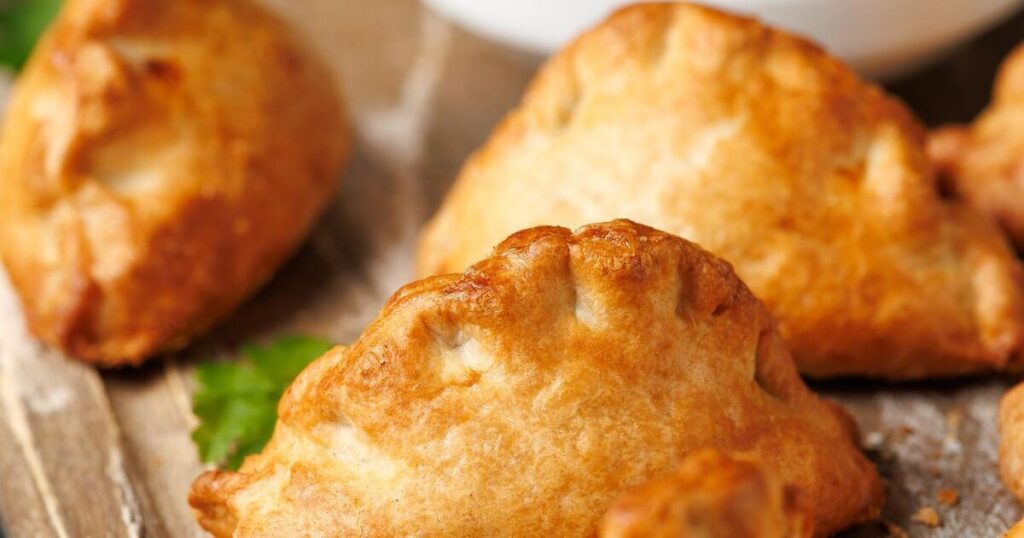Pasties, a filling encased in a crisp pastry, are prevalent in many cultures and there are endless ways to combine savoury ingredients before stuffing them into the pastry.
Our nearest neighbour has a long history of turnover pastries, which started off as the preserve of the wealthy, and were then adopted by working families.
A ready-made meal that could be eaten down a mine, or on a sailing ship, they required neither cutlery nor fuss.
I have learnt that a “tinners” pasty was both sweet and savoury. A miner’s wife would add some fruit to one end of the pasty as a dessert after the savoury end was eaten.
Empanadas are similar in make-up to pasties, originating in Spain and travelling to Latin America where they were shaped and adapted to suit local ingredients and diets.
There is a debate on whether to precook the filling or not for this type of pastry. I find you get richer and tastier results when you pre-cook.
Sautéing the shallots sweetens them, helping create a rich gravy with the juices from the meat and combining all of the ingredients with the rich liquid.
Pasties
Sautéing the shallots sweetens them, helping create a rich gravy with the juices from the meat and combining all of the ingredients with the rich liquid.
Preparation Time
30 mins
Ingredients
-
for the pastry:
-
150g cold butter, cut into small cubes
-
300g plain flour
-
1 pinch fine sea salt
-
2 eggs, beaten and an extra 1 for the glaze
-
2 tbsp cold water
-
for the filling:
-
a dash rapeseed oil
-
1 shallot, finely diced
-
3 cloves garlic, finely chopped
-
1 red chilli, finely chopped
-
380g minced beef
-
2 tsp smoked paprika
-
1 tsp ground cumin
-
½ tsp cracked black pepper
-
1 tbsp tomato purée
-
20g olives, de-stoned and chopped
-
100ml stock
Method
-
To make the pastry, rub the cold butter into the flour and salt until it looks like rough breadcrumbs.
-
Stir the cold water and egg together and add it to the flour mixture until combined. Knead it gently and just enough to combine the ingredients well.
-
Wrap the pastry in baking parchment and place into the fridge for about three hours.
-
Heat the rapeseed oil and sauté the shallots until translucent, add the garlic and chilli and stir them through the shallots.
-
Add the mince and break up any lumps, cook until all of the meat is browned.
-
Add the paprika, cumin, black pepper and tomato purée as well as the olives and stock.
-
Allow to bubble away for ten minutes until the meat is cooked through and the liquid has reduced.
-
Set aside to cool.
-
Preheat your oven to 220ºC/gas mark 7 and line two large flat baking trays with parchment.
-
Roll the pastry cut out 6 circles about 7 inches in width.
-
Spoon about two tablespoons of filling into the centre of each disc leaving enough space so you can comfortably seal in the edge.
-
Fold the pastry discs over and seal around the edges by pinching the pastry tightly to crimp the edge. Make a tiny hole with the tip of a knife to let air out as it bakes.
-
Brush each parcel with the beaten egg and place onto the prepared trays.
-
Bake for about 5 minutes then turn your oven down to 180ºC/gas mark 5 and bake for another 25 minutes until golden.
-
Once cool enough to handle transfer onto a wire rack to cool completely.
- Turning the oven up high at the beginning helps to create a crisp crust on your pastry and helps prevent a soggy bottom.
- Piercing a small hole in the top of each pasty allows the steam to escape and will stop them bursting open as they bake.
- Your pasty should end up being shaped like a ‘D’. Use your fingers to press the edges of the pastry together to seal it well. You want to make sure the edges are firmly pressed to prevent any filling from leaking out during baking.
- I tend to make my pastry by hand, but you can use a food processor if you wish. A food processor works well as the trick to pastry is keeping it cool and working the butter with your hands can warm it up too much. Whichever method you choose, you will still need to allow the pastry to rest and cool in the fridge before rolling it.
- Make sure you leave the pasties to cool before eating, they can appear cool on the outside and still be piping in the centre.
- You can make the pasties ahead of time and keep them in the fridge for a few hours until you are ready to bake them.
- You can also freeze them when they are unbaked. You can then bake them straight from the freezer. Add 15-20 minutess extra baking time and double check that they are piping hot all the way through.
Chorizo can really spice up a pasty, and add plenty of flavour and colour. In place of the minced beef, add half diced chicken (I use thigh) and half diced chorizo.
In place of the olives, add peas. You do not need to add the paprika as the chorizo contains plenty of it.
You can use lamb mince instead of beef mince in this recipe and add one medium-sized diced potato when sautéing the veg at the beginning.
You will need to dice the potato very small and use a firm, waxy variety so they hold their shape.
In place of the beef, you can use minced chicken and add diced carrots into the shallots when you are sautéing.
For this version, you can also vary your spices, I think nutmeg works well here.


